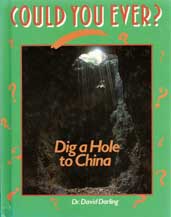COULD YOU EVER DIG A HOLE TO CHINA?: Glossary
aluminum
A light metal that is common in rocks of the Earth's crust.
basalt
A dark-colored and fairly heavy type of rock that is formed from cooling magma. Basalt makes up most of the thin crust beneath the oceans.
bedrock
The solid, unbroken layer of rock that lies just below the Earth's surface.
billion
One thousand million. Written as 1,000,000,000.
carbon dioxide
A gas which human beings and other animals breathe out. It occurs in both the air and the soil of our planet.
carbonic acid
A weak acid that is formed when carbon dioxide dissolves in water.
core
The central part of the Earth. The core is divided into two parts: a solid inner core and a liquid outer core, both containing iron and nickel.
crust
The outer "skin" of the Earth made up of cool, mainly lightweight rocks.
fossil fuel
A fuel, such as coal, oil, or natural gas, that formed in the Earth's crust from the squashed remains of animals and plants that died hundreds of millions of years ago.
granite
A hard, grainy rock, common in the Earth's crust, made up of tiny crystals of various substances.
gravity
A force exerted by any object that has mass (the amount of material it contains). The Earth's gravity is the force that prevents the atmosphere, and people, from floating away into space.
helium
The second lightest and second most common gas in the universe.
hydrogen
The lightest, most common substances in the universe.
iron
A heavy metal that makes up much of the Earth's core.
limestone
A whitish or yellowish rock formed from the hard parts of sea animals and plants that died millions of years ago.
M-discontinuity
The thin boundary layer that separates the mantle from the core. Its full name is Mohorovicic discontinuity after the Yugoslavian scientist who discovered it.
magma
Molten rock that comes from a hot, liquid layer at the top of the mantle. Magma reaches the Earth's surface in great cracks under the world�s oceans and volcanoes.
magnesium
A lightweight metal commonly found in rocks of the Earth's crust.
magnetic field
A region in which a force of magnetism can be felt. The Earth's magnetic field is caused by currents circulating through the liquid iron of the outer core.
mantle
The middle layer of the Earth lying between the core and the crust.
nickel
A heavy metal, similar to iron, that occurs at the Earth's core.
plate
The name given to a large piece of the Earth's crust that can move about on the molten rocks of the mantle below.
plate tectonics
A scientific theory that explains how plates are formed, move about, and interact with one another.
seismograph
An instrument for measuring shock waves that have traveled through the Earth, usually following an earthquake.
silicon
A substance that is common throughout the Earth's mantle and crust. It is often combined with oxygen to form a group of minerals called silicates. Sand also contains a large amount of silicon.
solar system
The name given to the Sun and everything that goes around it, including the planets and their moons.
subsoil
A layer, between a few inches and a few feet below the surface. which is coarser than the topsoil and contains pieces of rock broken off from the bedrock.
topsoil
The uppermost layer of the Earth's surface, made largely from decayed plants.
tunnel-boring machine
A large machine that uses powerful cutting teeth to bore through earth and rock.
water vapor
The invisible gas that forms from water.

